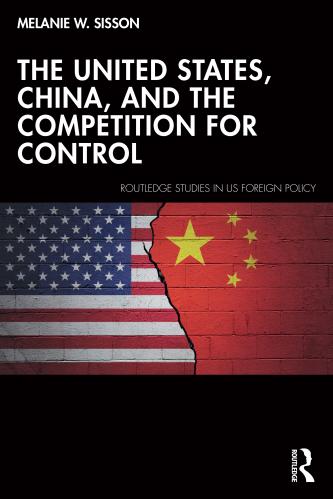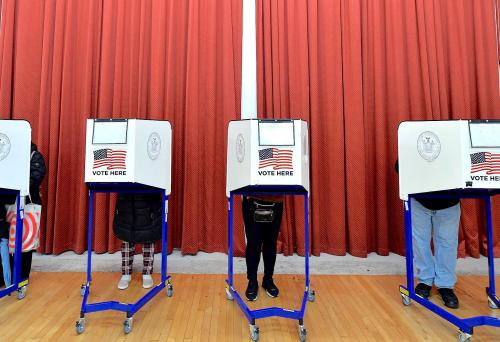In a new “Unpacked” video, published in February 2018, Senior Fellow Elaine Kamarck explains gerrymandering and options to fix it. See another “Unpacked” video from expert Russell Wheeler on the Supreme Court gerrymandering cases.
The U.S. Supreme Court recently announced that it will hear a Wisconsin case on political gerrymandering, the practice of drawing legislative boundaries that favors one political party (the one in charge of drawing the lines) in elections. The case will focus not on questions of racial bias, which was at issue in a May Supreme Court ruling on two North Carolina congressional districts, but on partisanship and unequal representation. The most recent Supreme Court ruling in a political redistricting case occurred in 2004, in Vieth v. Jubelirer.
What does research tell us about the relationship between gerrymandering and what Brookings Senior Fellow Thomas Mann has called “the hyper-partisanship that paralyzes our politics and governance”? And, what are the solutions?
The origin of gerrymandering
 Gerrymandering first entered the American vernacular in 1812 when Massachusetts Governor Elbridge Gerry, a signer of both the Declaration of Independence and the Articles of Confederation (he refused to sign the U.S. Constitution), signed a redistricting bill into law that benefitted his party over the Federalists, who held a majority among voters in the Commonwealth. The response was resoundingly negative: “A new species of Monster, which appeared in Essex South District in Jan. 1812,” blared an anonymous broadside printed in The Boston Gazette on March 26, 1812. The drawing represented the Essex South state senatorial district for the Massachusetts legislature, which had been drawn to not only resemble a salamander, but also to benefit the Democratic-Republican party in the state. Although the practice of drawing legislative boundaries for political benefit existed in 18th century American politics, the origin of the term “gerrymander” made its debut in this article.
Gerrymandering first entered the American vernacular in 1812 when Massachusetts Governor Elbridge Gerry, a signer of both the Declaration of Independence and the Articles of Confederation (he refused to sign the U.S. Constitution), signed a redistricting bill into law that benefitted his party over the Federalists, who held a majority among voters in the Commonwealth. The response was resoundingly negative: “A new species of Monster, which appeared in Essex South District in Jan. 1812,” blared an anonymous broadside printed in The Boston Gazette on March 26, 1812. The drawing represented the Essex South state senatorial district for the Massachusetts legislature, which had been drawn to not only resemble a salamander, but also to benefit the Democratic-Republican party in the state. Although the practice of drawing legislative boundaries for political benefit existed in 18th century American politics, the origin of the term “gerrymander” made its debut in this article.
As it happened, Gerry was no longer governor when this broadside appeared, having lost his re-election bid to Federalist Caleb Strong. Gerry would go on to serve as James Madison’s vice president until his death in 1814.
How are districts drawn today?
According to a 2013 Harris Poll, 71 percent of Americans—conservatives, moderates, and liberals alike—believe that “those who stand to benefit from redrawing congressional districts should not have a say in how they are redrawn.”
But the reality is quite different. For purposes of drawing boundaries for the U.S. House of Representatives only (as opposed to state legislative districts, which have different procedures across the states) the procedures vary widely from state to state. Consider this:
- 37 state legislatures draw congressional boundaries
- 6 of these 37 legislatures have either advisory or backup commissions
- 4 states use an independent commission: Arizona, California, Idaho, and Washington
- 2 states use politician commissions: Hawaii and New Jersey
- 7 states have only one congressional district each, so do not draw boundaries for the U.S. House (but they do for their own state legislatures)
For the states where the legislature conducts redistricting, some plans are approved by a simple majority in each chamber; some require two-thirds majorities; and others require a joint resolution, which the governor cannot veto.
Independent commissions limit the participation of elected officials.
More detailed information about how districts are drawn, including for state legislatures, can be found here and here.
How does gerrymandering relate to political polarization?
Polarization in American politics is a well-studied phenomenon, and it has been rising over the past few decades. But does gerrymandering itself cause or contribute to this divide? Brookings scholars who study the matter agree that it is not the primary cause of polarization, though this conclusion doesn’t mean that redistricting reform isn’t necessary.
But the more salient problem, experts observe, is that Americans are sorting themselves politically, regardless of how congressional district boundaries are drawn. In her paper on increasing voter turnout in congressional primaries, Senior Fellow Elaine Kamarck, founding director of the Center for Effective Public Management at Brookings (CEPM), noted that:
The bigger problem with relying on gerrymandering reform to increase competition is that in recent years Americans seem to have “sorted themselves” into like-minded communities. … In recent years, red states have gotten redder, blue states bluer and the same holds for counties. Thus even in the unlikely event of across the board redistricting reform, the increase in competitive congressional districts may not be very big.
Similarly, University of Denver professor Seth Masket explained in a CEPM paper that “districts tend to polarize more between redistrictings than during them. That is, this is more a phenomenon of voters sorting themselves into more ideologically homogeneous districts than it is politicians drawing such districts.” He adds that “[redistricting reform’s] prospects for substantially reducing the partisanship of America’s politicians are modest at best.”
This is not a new conclusion. In 2010, Senior Fellows Thomas Mann and William Galston wrote that “because people increasingly prefer to live near others who share their cultural and political preferences, they are voting with their feet and sorting themselves geographically. … Many more states and counties are dominated by one-party supermajorities than in the past. Contrary to widespread belief, reducing the gerrymandering of congressional districts would make only a small dent in the problem.”
Kamarck and Galston note an additional problem related to congressional redistricting: the negative effect it has on moderate voters, and the subsequent increase this (and other factors) has on polarization. “Congressional districts,” they wrote, “are drawn in ways that make nearly all of them safe for one or another of the major political parties. Considered in tandem with low-turnout primaries, gerrymandering further diminishes the influence of moderates.”
To fix this problem, they advised that “states should take redistricting out of the hands of legislatures and entrust it to nonpartisan commissions—as some states, such as Iowa, already have.”
In a paper for Third Way, Galston and Kamarck elaborated on three reasons why American politics are so polarized: the current system for primaries; redistricting; and the congressional leadership system. Again, these “systemic structural problems … silence the voice of moderate voters.” But the clustering of Americans into like-minded communities, they argued, makes redistricting reform not the ultimate solution to the problem of polarization. “Given these trends,” they wrote, “there is clearly a limit to the number of competitive Congressional districts that could be created if redistricting were removed from the self-interested political process in state legislatures and gerrymandering reduced.”
What can, or should, be done about gerrymandering?
While scholars agree that gerrymandering is not the leading cause of political polarization, and that eliminating it would not necessarily increase legislative competitiveness, they agree that partisan redistricting can amplify partisan divides, and that efforts should be taken to increase transparency and decrease partisan influence in the redistricting process.
As Mann wrote in The National Voter, “Redistricting reform cannot by itself reverse these trends toward declining electoral competition, increasing ideological polarization between the parties, and smash-mouth partisan manipulation of the electoral rules of the game.” He continued that:
The country is evenly divided between the two parties. Most voters have sorted themselves into a party by their ideological views, and their decisions on where to reside have promoted a geographical segregation of like-minded citizens—conservatives to the exurbs, liberals to cities. Furthermore, partisan attachments powerfully shape political perceptions, beliefs and values, and incumbents enjoy advantages well beyond the way in which their districts are configured. All of these forces will continue to shape our politics no matter what initiatives are taken to improve the process. Redistricting reform is no panacea, but it is a start.
Independent redistricting commission
As previously noted, a handful of states use independent, non-partisan commissions to draw their congressional districts. In a 2015 Supreme Court decision (Arizona State Legislature v. Arizona Independent Redistricting Commission), the court found that Arizona’s voters had the constitutional authority to achieve redistricting through an independent commission rather than by the state legislature. Mann called this decision “a model of constitutional reasoning and statutory interpretation,” one that “strengthens the legitimacy of representative democracy by reinforcing the essential link between republican government and popular sovereignty.”
Transparency and Public Participation
In 2010, scholars from Brookings and the American Enterprise Institute collaborated on promoting transparency in redistricting. Calling the drawing of electoral districts “among the most easily manipulated and least transparent systems in democratic governance,” the group laid out a set of transparency principles and recommendations for promoting public participation. “Increasing transparency can empower the public to shape the representation for their communities,” they argued, plus “promote public commentary and discussion about redistricting, inform legislators and redistricting authorities which district configurations their constituents and the public support, and educate the public about the electoral process.”
Crowd-sourced redistricting maps
Former Brookings experts Micah Altman and Michael McDonald have studied the use of crowd-sourced mapping to “improve political representation and detect a gerrymander.” Through their research on public redistricting in key states, they “discovered that members of the public are capable of creating legal redistricting plans that outperform those maps created by legislatures in a number of ways.” Altman and McDonald concluded that the tradeoff between improving competitiveness without threatening the majority-minority districts that gerrymandering often creates “is a tradeoff we should gladly accept.”
Mann and AEI’s Norm Ornstein (the two are co-authors of “It’s Even Worse than It Looks: How the American Constitutional System Collided with the New Politics of Extremism”) recounted how they judged student plans in Virginia using public mapping software. “The best student plans show that it is possible to create more legitimate and responsive districts—and that with the right tools, citizens anywhere can create better plans to choose their representatives than the representatives do to protect their own careers. While politicians may fight to keep the process closed, the tools are available to enable us to do better.”
—
“Partisan gerrymandering is not the major source of our dysfunctional politics,” Mann wrote in the wake of the Arizona decision, “but it surely reinforces and exacerbates the tribal wars between the parties.”
Thus, on the question of whether gerrymandering is the primary driver of partisan polarization in American political institutions, especially the U.S. Congress, the answer is a qualified “no.” Other factors contribute to polarization, especially residential self-sorting by American voters, the primary process, and how congressional leaders are picked. But, the practice of gerrymandering does have, as Brookings scholars have observed, other pernicious effects, including diminishing transparency in how the political process works and giving legislators too much power over who their voters. These in turn contribute to falling trust in political institutions, and in an era in which public confidence in political institutions is at a crisis point, the continued practice of partisan congressional boundary drawing only reinforces that downward trend. As Mann wrote in Time magazine last year, “In an era in which partisanship determines the electoral choices of most voters and the behavior of elected representatives in Congress and state legislatures, it is essential that the collective will of the electorate be reflected in the partisan composition of legislatures. Yet this straightforward notion of partisan fairness is often undermined by partisan gerrymandering.”
The Brookings Institution is committed to quality, independence, and impact.
We are supported by a diverse array of funders. In line with our values and policies, each Brookings publication represents the sole views of its author(s).






Commentary
A primer on gerrymandering and political polarization
July 6, 2017